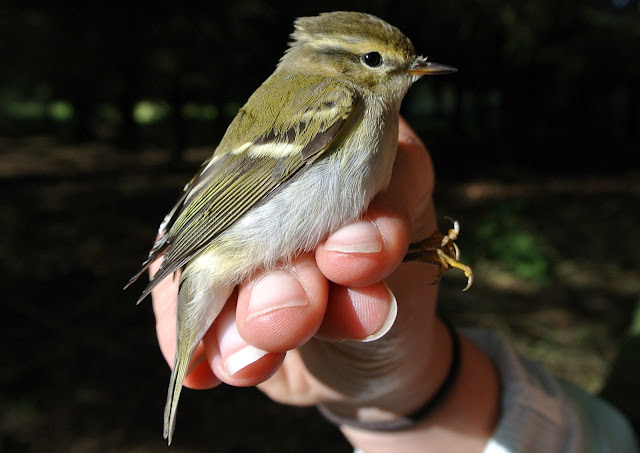It's been a fantastic few days, although frustrating at times. The beautiful clear skies that saw such Bardsey scarcities as
Red Kite,
Hen Harrier and
Hooded Crow drift across to our shores continued into the night, before a light drizzle and total darkness descended. The conditions were perfect for a lighthouse attraction and it was no surprise at 0200 when the first
Redwings started calling. The night of the 22nd/23rd saw a total of 102
Redwings, three
Fieldfares, 13
Blackbirds, 10
Song Thrushes, two
Black Redstarts, 195
Starlings, a
Robin, four
Goldcrests, a
Chiffchaff, a
Snipe, a
Woodcock and a
Manx Shearwater attracted. That Spurn had more birds attracted to their moth trap (and remembering that Bardsey Lighthouse is visible for roughly 43km), highlights a slight difference in the numbers of birds passing down each coast of the UK at the moment. It was still an impressive spectacle however, and using the diversionary lights through the night we managed to keep fatalities down to just two
Redwings. The murk continued the next day but it was soon clear that a few more exciting birds had also reached our shores. A pipit with a rather short, buzzing call toured the lowlands before vanishing. It certainly sounded
Olive-backed Pipit-like, but is yet another bird to get away this year. A
Little Bunting showed very briefly for one observer before doing a similar disappearing act. Surely these birds couldn't be leaving the island. But then a
Richard's Pipit showed that birds could definitely move straight through in the gloom by coming in past the Lighthouse, straight up the island, and out to sea to the North. A supporting cast of five
Yellow-browed Warblers, three
abietinus-type
Chiffchaffs, a
Firecrest, five
Black Redstarts, a
Long-eared Owl and a rather eastern looking
Lesser Whitethroat all made for exciting birding.
Up until this season 62 Yellow-browed Warblers had been ringed on Bardsey. A further five have been ringed so far this autumn. (c) Richard Brown
The classic Bardsey view: a large pipit with a long tail flies over and gives a loud, hoarse shreep a few times before keeping on going. There have been five such flyovers so far this year. The Richard of the bird's English name is Richard of Luneville, a French naturalist and collector. (c) Richard Brown
The top photo is the Long-eared Owl Rich found a couple of days ago. Good news for Bardsey's youngest birder is that it isn't in wing moult (so he can have the lower bird on his self-found list). The second Long-eared Owl of the year flushed into the Obs garden and hit a mist net set up to catch a couple of Yellow-browed Warblers. It is the 21st adult Long-eared Owl to be ringed on Bardsey. The primary moult suggests an adult bird. (c) Richard Brown
A rather eastern-looking Lesser Whitethroat. Not as short winged and fine-billed as minula, it looks good for a halimodendri/blythi type bird. Lots of white in the tail, rather blunt winged and an occasional Mistle Thrush-like rattle to the call. (c) Richard Brown
.JPG)
.JPG)
.JPG)
.JPG)
.JPG)
.JPG)
.JPG)
.JPG)
.JPG)
.JPG)
.JPG)
.JPG)
.JPG)
.JPG)
.JPG)
.JPG)
.JPG)
.JPG)
.JPG)
.JPG)
.JPG)
.JPG)
.JPG)
.JPG)
.JPG)
.JPG)
.JPG)
